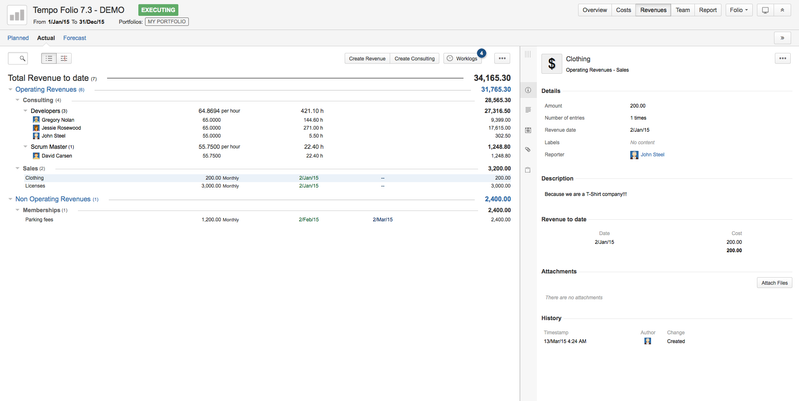Non-Consulting Revenues
Non-consulting revenues are all revenues that a project can generate other than the revenues generated by billed worked hours. They can include sales, interests received on investments, etc. They are categorized in two broad Categories: Operating and Non-operating. Non-consulting revenues can be single occurrence ones or recurrent. Recurrent revenues can also be amortized in which case the amount associated with received payments will be evenly split on the payment period.
 Categories
Categories
Tempo Budgets uses a classic categorization of revenues to better structure your income. Every revenue belongs to one of two main categories: Operating and Non-Operating. You should define revenues in their appropriate category so that you can later get relevant information about the categories themselves, like the total operating revenues.
Operating
Operating revenues are the day-to-day revenues earned during the execution of a project, such as the consulting services and inventory sales.
Non-Operating
Non-Operating revenues are the portion of an organization's income that is derived from activities not related to its core operations. Non-operating revenues would include such items as dividend income, profits (and losses) from investments, gains (or losses) incurred due to foreign exchange and asset write-downs.
Revenue Recurrence
Non-consulting revenues can be defined to be recurrent using the Recurrence dialog that appears when clicking the Edit link of the Recurring field in the revenue edition dialogs. See Recurrence for more information.
Recurrent revenues can be amortized in which case their received payments will be evenly spread upon their recurrence period. For instance, a monthly amortized revenue of 1,200$ that is defined to recur for 1 year will result in 12 received payments of 100$ each occurring once a month. See the Revenue Calculation section below for more examples on amortized expenses.
Revenues and Folio's Time Frame
Expenditures and revenues can be defined to occur outside of a Folio's time frame. Consequently, you can specify:
Revenue Calculation
The amount of a non-consulting revenue is calculated by multiplying its payment amount by the number of payments.
Amoun = Number of payments x Payment amount
The number of payments depends on the recurrence definition for that revenue and the Folio's time frame. Only revenues occurring (inclusively) between the Folio's start and end dates (see Folio Configuration) are taken into account.
Note also that non-working days are not taken into account (e.g. a rent income won't be skipped if the incurrence date is a holiday).
Amount: 100$
| Recurrence definition | Monthly on day 1, from 1/Feb/2014 |
| Folio time frame | 1/Jan/2014 to 1/May/2014 |
| Number of payments | 4 (February 1st, March 1st, April 1st and May 1st) |
| Payment amount | 100$ |
| Cost | 4 x 100$ = 400$ |
|---|
Amount: 100$ (amortized)
| Recurrence definition | Monthly on day 1, from 1/Feb/2014 |
| Folio time frame | 1/Jan/2014 to 1/May/2014 |
| Number of payments | 4 (February 1st, March 1st, April 1st and May 1st) |
| Payment amount | 100$ / 4 = 25$ |
| Cost | 4 x 25$ = 100$ |
|---|
Related pages:
Tempo for Server Documentation
For the newest versions of Tempo documentation, please visit our Help Center. For support, see our Support Portal.